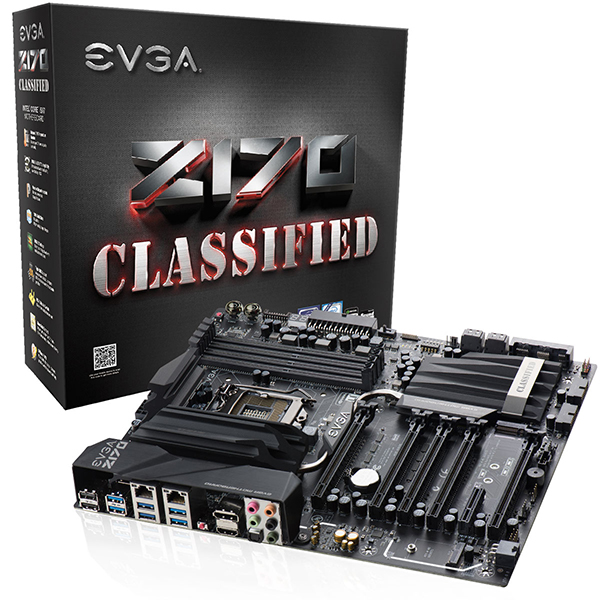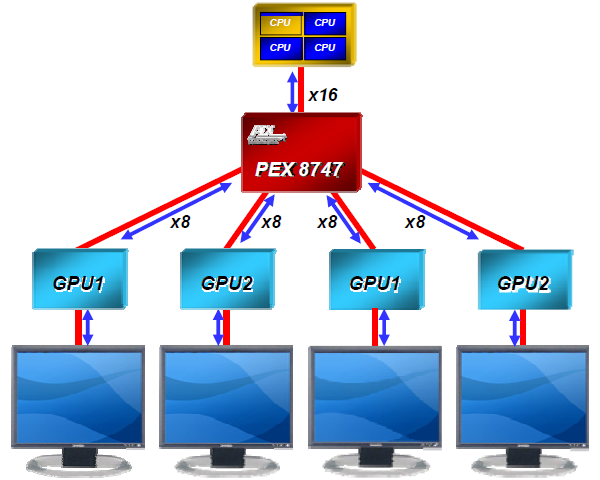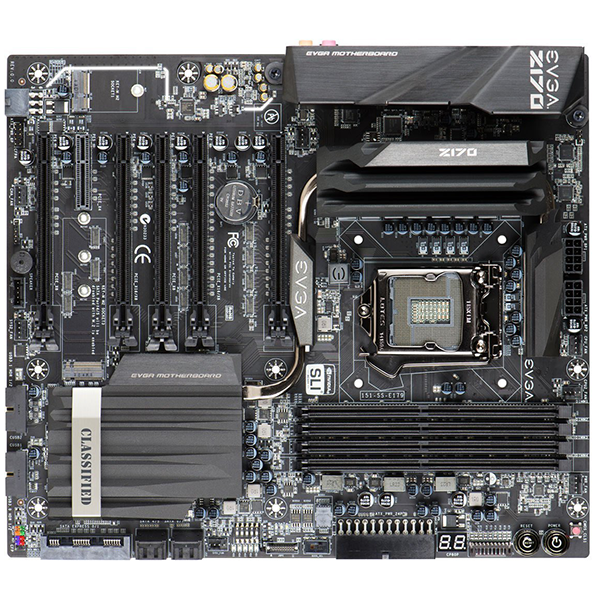Early Verdict
A solid overclocker and the least-expensive multi-way SLI motherboard for Skylake processors, EVGA’s Z170 Classified fills a market gap not-yet-approached by its rivals.
Pros
- +
Top four-DIMM DRAM and BCLK overclocking results, 3-way and 4-way SLI capability, triple BIOS.
Cons
- -
Poor boot failure recovery, high price, PEX 8747 gets only eight lanes of bandwidth (but reports x16 for connected cards).
Why you can trust Tom's Hardware
Multicast For The Win!
Economics dictates why Skylake only has sixteen PCIe 3.0 lanes, as the same LGA 1151 socket is meant to serve everything from low-end office to mainstream gaming machines. If you want more than that, Intel thinks you should upgrade to a bigger processor on a more expensive board. The problem is, Intel's big processors are always clocked slower using previous-generation technology. Using client systems to work the bugs out of a core before transitioning its tech to servers might make sense to an IT manager, but performance enthusiast don’t like this CPU/GPU performance dichotomy. While some resort to extreme cooling to make up for the per-core performance deficit with added clock-speed, the new cores usually clock even higher on even less cooling for far less money.
Because every card in an SLI or CrossFire array uses exactly the same data, a repeater switch that sends four copies of the same data to four cards works nearly as well as a PCIe controller that has four times as many lanes. NVidia called this “Broadcast mode” when marketing its earlier solution, and Avago now calls it Multicast in the PEX 8747. The firm’s marketing image still carries the PLX logo of its subsidiary.
EVGA doesn’t exactly stick to the script though. Knowing that “nearly as well” isn’t good enough for those few customers who can’t live with the slight latency penalty of the PEX 8747 switch, it provides them with the single PCIe 3.0 x16 direct CPU pathway option on the board’s top slot. Adding a card to any of the other PCIe x16 slots forces the top slot to donate eight pathways to the PCX 8747. Because the Z170 Classified only serves the PEX 8747 with eight input lanes, all connected devices have a maximum of eight lanes bandwidth, even though these may be detected as having 16 pathways.
MORE: Best MotherboardsMORE:
How To Choose A MotherboardMORE: All Motherboard Content
Get Tom's Hardware's best news and in-depth reviews, straight to your inbox.
-
AndrewJacksonZA I think I'll add this to my wishlist... I would like for it to be available in white, but then again, if a user is running four graphics cards, how much of the motherboard will actually be seen? :-)Reply -
firefoxx04 Not sure how I feel about the price. Surely you can get a socket 2011-3 board for the same price?Reply
Either way you are going to need expensive ddr4 and the cost of the cheapest haswell-e chip isn't that much more than the top of the line skylake i7.
Going with those board and a quad core might get you support for more gpus but it's still not the same as the native support that haswell-e offers and I bet the price is similar. I don't have time to crunch numbers so it's just speculation.
I just feel that anyone who needs that kind of graphics power is going to understand why they might want haswell e over skylake right now. -
SylentVyper ReplyNot sure how I feel about the price. Surely you can get a socket 2011-3 board for the same price?
Either way you are going to need expensive ddr4 and the cost of the cheapest haswell-e chip isn't that much more than the top of the line skylake i7.
Going with those board and a quad core might get you support for more gpus but it's still not the same as the native support that haswell-e offers and I bet the price is similar. I don't have time to crunch numbers so it's just speculation.
I just feel that anyone who needs that kind of graphics power is going to understand why they might want haswell e over skylake right now.
This. If I'm running 4 GPUs, they're most likely going to be one of the top performing GPUs out anyway, and I wouldn't want a 4c/8t i7 trying to power 4 980 Ti's along with trying to compute what you're going to be running (4k or more).
5820k with EVGA Classified board:
(http://pcpartpicker.com/p/TnLtLk) / (http://pcpartpicker.com/p/TnLtLk/by_merchant/)
Type|Item|Price
:----|:----|:----
**CPU** | (http://pcpartpicker.com/part/intel-cpu-bx80648i75820k) | $379.99 @ B&H
**Motherboard** | (http://pcpartpicker.com/part/evga-motherboard-151hee999kr) | $374.27 @ Amazon
| *Prices include shipping, taxes, rebates, and discounts* |
| **Total** | **$754.26**
| Generated by (http://pcpartpicker.com) 2015-11-11 10:37 EST-0500 |
6700k with Classified:
(http://pcpartpicker.com/p/FyRfLk) / (http://pcpartpicker.com/p/FyRfLk/by_merchant/)
Type|Item|Price
:----|:----|:----
**CPU** | (http://pcpartpicker.com/part/intel-cpu-bx80662i76700k) | $374.99 @ Newegg
**Motherboard** | (http://pcpartpicker.com/part/evga-motherboard-151sse179kr) | $399.99 @ Amazon
| *Prices include shipping, taxes, rebates, and discounts* |
| **Total** | **$774.98**
| Generated by (http://pcpartpicker.com) 2015-11-11 10:38 EST-0500 |
The Haswell-E is actually slightly cheaper, and you get more brute force. I would probably spring for a higher end chip though, if I'm already spending over $2k on GPUs alone :P -
xenol Huh, the broadcasting of PCIe data over the video cards since they're using the same data feels like a pretty damn elegant solution.Reply
*Armchair engineering moment* Maybe in the future instead of these chips being necessary, the GPUs boot up in PCIe x1 to send data and the CPU can figure out if there's a multi-GPU setup or not, and if there is, broadcast to all the GPUs.
I'm doubting GPUs need a full x16 duplex communication anyway, most of their bandwidth is receiving. -
Crashman Reply
EVGA X99 Classified does not support 4-way SLI on the Core i7-5820k :-)16930601 said:Not sure how I feel about the price. Surely you can get a socket 2011-3 board for the same price?
This. If I'm running 4 GPUs, they're most likely going to be one of the top performing GPUs out anyway, and I wouldn't want a 4c/8t i7 trying to power 4 980 Ti's along with trying to compute what you're going to be running (4k or more).
5820k with EVGA Classified board:
Intel Core i7-5820K 3.3GHz 6-Core Processor $379.99
EVGA X99 Classified EATX LGA2011-3 Motherboard $374.27
**Total** | **$754.26**
6700k with Classified:
Intel Core i7-6700K 4.0GHz Quad-Core Processor $374.99
EVGA Z170 Classified EATX LGA1151 Motherboard $399.99
**Total** | **$774.98**
Then again, 3-way SLI gets more performance per card, maybe you don't need the fourth card. -
kittle Neat idea to improve gaming performance. But i suspect it will play major havok with GPU Compute based tasks when it sends the same data to all cards vs selected cards.Reply
I dont suppose any of the benchmarks verified this? -
Crashman Reply
I'm pretty sure the entire idea is to combine the fastest CPU with the fastest graphics configuration in games. The switch can still act in non-broadcast mode, but you're probably better off with more cores and more direct lanes if you're running compute apps.16933431 said:Neat idea to improve gaming performance. But i suspect it will play major havok with GPU Compute based tasks when it sends the same data to all cards vs selected cards.
I dont suppose any of the benchmarks verified this? -
mapesdhs Mbd makers have been doing this sort of thing for years, but it died out after Z77, possibly Z87. Heck, I have an ASUS P55 board that can do x8/x8/x8/x8, I hold a few 3DMark P55 records with it using three 980s.Reply
Thus, I hope site reviewers don't treat this as something new because it isn't. SylentVyper is right, X99 makes more sense for 3 or 4 GPUs, though I'd use an ASUS board rather than EVGA, it'd oc better. My favourite is the X99-E WS (which supports x16/x16/x16/x16 and is only +50 over the Classified) but I suppose others might opt for the Deluxe or whatever. I wouldn't buy the 5820K though (and one can't if one wants 4-way GPU), it restricts PCIe options too much, affecting other things like M.2 availability, etc.
-
Crashman Reply
Chill dude, this is the first Z170 tested with the part, we have Z97s and Z87s with the same part. And before that Nvidia had a PCIe 2.0 version.16933483 said:Mbd makers have been doing this sort of thing for years, but it died out after Z77, possibly Z87. Heck, I have an ASUS P55 board that can do x8/x8/x8/x8, I hold a few 3DMark P55 records with it using three 980s.
Thus, I hope site reviewers don't treat this as something new because it isn't. SylentVyper is right, X99 makes more sense for 3 or 4 GPUs, though I'd use an ASUS board rather than EVGA, it'd oc better. My favourite is the X99-E WS (which supports x16/x16/x16/x16 and is only +50 over the Classified) but I suppose others might opt for the Deluxe or whatever. I wouldn't buy the 5820K though (and one can't if one wants 4-way GPU), it restricts PCIe options too much, affecting other things like M.2 availability, etc.
-
dudmont Had this in my pcpartpicker skylake build since it came out. Think about this, you can sli and have no less than three m.2 pcie3x4 ssds. Can't do that with a 5820. Probably can't do with a 5930(*pondering Homer Simpson style). Buy 2 PCIE m.2 adapter cards, you could set up 2 950 pro 512, in raid. Lots of interesting options.Reply



